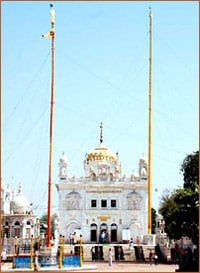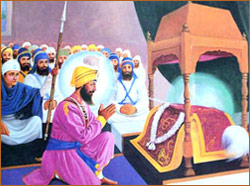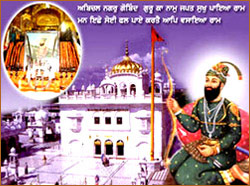Countdown to 300 years
On 15 November 2007 at 4.30pm IST (Indian standard time) (11 am GMT and 6am EST-USA;) the Takhat Sachkhand Sri Hazoor Sahib Gurdwara will begin the countdown to the 300th year of guruship of Guru Granth Sahib in October 2008. To mark this occasion, the Gurdwara is asking all Sikhs to recite the Mool Mantar for 15 minutes at this time. The organisers have stated:
- "MEDITATE, PARTICIPATE, CELEBRATE: Over 15 million Sikhs across the world will celebrate Simran Divas. An auspicious occasion that will flag off the year long celebrations marking 300 years of "GURTA GADDI' at Nanded in October, 2008. Share your love and devotion by reciting the "Mool Mantar" wherever you may be. Let us meditate, participate, celebrate together 300 saal guru dey naal"
The tercentenary celebration of the Guruship of Sri Guru Granth Sahib is to be undertaken on a massive scale next year in October 2008 at Takhat Sachkhand Shri Hazur Abchalnagar Sahib in Nanded, Maharashtra, India. The historic town of Nanded is an important place in Sikhi because it is where Takht Sri Hazur Sahib, one of the five temporal thrones or seats of authority (Takhats) is located. This is where Guru Gobind Singh, the Tenth Teacher, is known to have meditated on the banks of river Godavari and where he spent his final days.
"The Eternal Father willed and thus I raised the Panth. All my Sikhs are hereby ordered to accept the Granth as their Preceptor. Have faith in the holy Granth, as your spiritual master and consider it the visible manifestation of the Gurus. He who hath a pure heart will seek guidance from its holy words.". These are the words uttered by Guru Gobind Singh, before he left for his heavenly abode (Parlok Gaman) along with his horse Dilbag on October 7, 1708 at Nanded in Maharashtra.
A few days before Parlok Gaman, Guru Gobind Singh ended the line of personal Guruship by appointing the “Granth Sahib” (Gur-Ta-Gaddi) as his official successor with the status of ‘Eternal Guru’. His objective was great and laudable. As the succession of human Gurus had come to an end; he fully realized that human beings are perishable, but noble ideas live forever – they are eternal. For this reason he made the Granth Sahib a repository of sublime ideals, a spiritual and secular guru that contains hymns of Muslim, Hindu, and Harijan saints in addition to the compositions of Sikh gurus. He thus entrusted the destiny of the Khalsa (the pure ones) not to a charismatic personality but to the Shabad Guru and the collective control of the community (Sangat). His sole mission was to restore mankind to a single brotherhood.
It was here that in the first week of Sept,1708, that a Bairagi Sadhu Madho Dass was baptized to Sikhism by Guru Gobind Singh ji and was given a new name – Banda Singh Bahadur. It was this great hero who in the next seven years (1709-1715) gave a sharp turn to the history of Sikhs by shaking the foundation of the Mughal Empire in the North-west and paved the way for the liberation of the Punjab in 1764-65.
Another disciple of the Guru — Bhai Santokh Singh was advised to continue to stay at Nanded and to start “Guru ka Langar” for the devotees.
Bhai Daya Singh and Dharam Singh, two of the Panj Piare (Five beloved Ones) who had offered their heads at the Guru’s call when the Khalsa was created in Kesgarh Fort of Anandpur Sahib on the Baisakhi Day of 1699, and had survived the battle of Chamkaur, subsequently died here.
A Gurudwara was constructed by Maharaja Ranjit Singh ji at the site where Guru Gobind Singh ji breathed his last. It took 5 years to complete (1832-1837). It is revered as "Sachkhand Sri Hazur Abchal Nagar Sahib". This historical shrine, which is one of the five Takhts (thrones) of the Sikhs is situated near the Godavari river. It is visited by lakhs of devotees throughout the year. It is a two-storey building. Its interior is artistically ornamented in the style of Harmandir Sahib, Amritsar. The walls of the inner room called Angitha Sahib have been covered with golden plates. The dome is polished and on the pinnacle is the kalash made of gold plated copper.
The building stands on a high base and has a small square room on the second floor bearing the gilded ribbed dome topped with a tall gilded pinnacle and umbrella shaped finial. There are some rooms in the basement too, so that the edifice is technically four-storied. Corners of the roof of the first floor are decorated with domed kiosks on octagonal pedestals. Other embellishments on the exterior included oriel windows and a fancy fencing on the roof top. Inside, the sanctum it is lined in marble decorated with inset work in floral patterns on lower parts of the walls and stucco and tukari work on the upper parts as well as on the ceiling.
Guru Granth Sahib is seated in the room in front of the sanctum during the day time only and at night it is brought inside and placed on a marbled platform. During the day there are some old weapons and other relics such as a golden dagger, a matchlock gun, a quiver with 35 arrows, two bows, a steel shield studded with precious stones and five golden swords. All these are placed on a marbled platform.
The building complex of the Takhat Sahib is spread over several hectares. It also includes two other shrines, Bunga Mai Bhago ji (comprising a large room where Guru Granth Sahib is seated) and Angitha Sahib (place of cremation).
Guru Gobind Singhji, while conferring Guruship on the holy Book, had named Nanded region as Abchalnagar (steadfast city). The word Sachkhand (region of Truth) was used to mean the abode of God.
Besides Gurdwara Sachkhand Sahib, other major Gurdwaras in Nanded area are Nagina Ghat , Banda Ghat, Sangat Sahib, Baoli Sahib, Mal Tekdi, Shikar Ghat, Hira Ghat and Mata Sahib, etc.
- The above based on article at hazursahib.com. Click for more details
See Also
- Tercentenary Celebrations of Guruship to SGGS
- Takhat Sachkhand Sri Hazoor Sahib
- Message of Guru Granth Sahib
- Guru Gobind Singh
- Guru Granth Sahib




